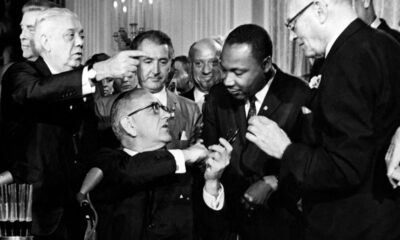Tarnell Brown is an economist and analyst from Atlanta.
Finance
Civil Asset Forfeiture: The War on Drugs™ as a Revenue Center for Law Enforcement

This is the third in my series on the social costs of drug prohibition. You can read part one here (prison-industrial complex) and part two (militarization of police) here.
In the decision of 1914 US v. Regan, the Supreme Court ruled that the “evidence rule requiring proof beyond a reasonable doubt generally applies only in strictly criminal proceedings.” This decision is relevant because it subsequently made civil legal actions possible in brake (against something, such as property) to be taken against those who have not been criminally charged in persoram. (to a person). In particular, Section 881 of Nixon’s Comprehensive Drug Abuse Prevention and Control Act of 1970 stated that all controlled substances would be forfeited, as would equipment used in the production and distribution of such substances (Stahl, 1992). With §881, the practice of civil asset forfeiture, the extrajudicial seizure of property suspected of being used (or benefitted) was born.
The addition of § 881(a)(6) in 1978 allowed for the seizure of both drug trafficking profits and anything purchased with those profits, while the 1984 addendum to § 881(a)(7) allows forfeiture of any property used to violate drug laws. Because the law enforcement agency responsible for seizing assets may keep the property – or the proceeds from its sale asset forfeiture has become a major source of revenue for these agencies. This has created a situation where a conflict between effective enforcement of the ban and revenue collection is all too often decided in favor of the latter (Boudreaux & Pritchard, 1996). This is made possible because of the different standards between criminal and civil proceedings; while crime suspects must be found guilty beyond a reasonable doubt, forfeiture victims need only be “reasonably suspected” of committing a crime.
Of course, reasonable suspicion is a highly subjective standard of proof, and existing laws provide little objectivity. This is not surprising, as asset forfeiture lies at the intersection of criminal and civil law. Depending on the case in question, the Court has made its ruling in brake forfeitures are considered criminal in some cases and civil in others. In reality, this vague distinction serves a purpose, as it allows law enforcement agencies to civilly punish individuals for suspected criminal activity without the increased burden of proof required for criminal prosecution. It then becomes the obligation of the individual whose property has been seized to prove his innocence after the fact, an often costly procedure that is a clear violation of due process protections. Unfortunately for these individuals, legal precedent has tended to view this protection as a matter for criminal prosecution, rather than a civil matter.
Police department budgets are subject to the same laws of scarcity as everything else, and every enforcement priority comes with an opportunity cost. For example, money and manpower spent on investigating car thefts cannot be used to investigate murders. In fact, research has shown that shifting resources to drug enforcement has reduced the opportunity costs of property crime, leading to its increase (Benson, Rasmussen, & Sollars, 1995). Asset forfeiture allows police departments’ drug enforcement apparatus to supplement their revenues. at little cost to the taxpayer other than the cost of seizure. Furthermore, individuals who have their assets seized are often permanently dispossessed, even if they are never found guilty of any crime.
Incentives to maintain this system extend far beyond local departments; while they keep the lion’s share of the proceeds – especially cash seizures – the funds are often dispersed. Williams (2002) notes that some departments share a small portion of revenues with local schools, health departments, and preferred nonprofits, while Blumenson and Nilsen (1998) note that courts also receive a portion of these funds, providing little incentive for the independence of the judiciary. protecting the property rights of forfeiture victims. All this contributes to a paradigm in which seizures are used instead of criminal convictions in violation of the law Fourth Amendment‘s exclusionary rule regarding evidence, and the focus of drug law enforcement has shifted from fighting crime to pursuing assets (Jensen & Gerber, 1996). Not only has this shift in focus not reduced crime, as we will explore below, there is also evidence that it has contributed to the increase in crime.













